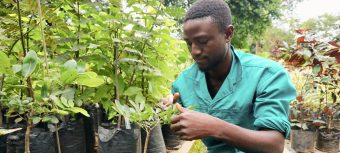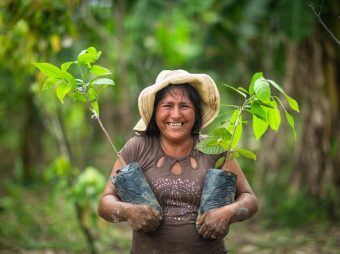
In 2018, the United Nations (UN) declared 2021-2030 as the UN Decade on Ecosystem Restoration in an effort to reverse centuries of damage to forests, wetlands and other ecosystems. The following year, as if to dramatize the urgency, fires swept through the forests of the Brazilian Amazon, Eastern Australia and the western coast of the United States. Coverage in both traditional and social media served as a global call to action, and millions of dollars have been since been mobilized to grow trees and restore forests and farms.
But campaigns like these can create a dilemma. Funders often have trouble finding people they can trust to do the hard work of planting trees. Planters must understand the land and ecology of the region, and know what kinds of trees will both survive and respond to the needs of a particular area. Funders also want to connect with projects that are equipped to manage the large volume of finance that is now being directed to trees.
TerraMatch, a new part of World Resources Institute’s (WRI) Global Restoration Initiative is designed to address those problems, connecting money with knowledge and shovels. The global platform uses an algorithm to match funding offers with projects that are run by experienced leaders, capable of getting the right trees into the right ground.
“People support tree-growing with various purposes in mind, but achieving those goals requires local expertise,” says Aaron Minnick, who manages TerraMatch. “And when funders and local people develop strategies together based on mutual understanding and common goals, they are also much more likely to succeed.”
The TerraMatch platform includes a website and an app with offline capabilities for iPhone and Android. It is accessible in English, Spanish, French and Portuguese. Funders benefit by receiving accurate information on vetted projects and local experts benefit from a connection to reliable, large-scale funding.
The power of trees
By any measure, trees are a smart investment. They keep the planet cool, absorb carbon and filter air pollution. They also mitigate natural disasters by regulating weather, stabilizing land, protecting crops and reducing opportunities for pathogens to pass between animals and people.

But growing trees the right way is not as simple as it sounds; history is full of examples of tree-planting gone wrong. Trees planted in grasslands in Australia, Brazil and South Africa have harmed local plants and animals and reduced water flows. And mesquite, planted in Kenya to combat desertification, grew so aggressively that it killed native vegetation, blocked roads and irrigation canals and resulted in significant economic and biodiversity loss for local people.
Connecting the dots
Over the past two years, public awareness and catastrophic natural disasters have created a tipping point, stimulating demand for government authorities and corporate entities to give back to the planet and restore the Earth’s dwindling resources.
In fact, Minnick says the pressure has been such that “companies, non-governmental organizations and governments are now earmarking money at a rapid pace, specifically for this purpose.”
Through the TerraMatch technique, WRI has channelled more than US$2 million from funders to local experts. In Rwandan farms and forests, women-led cooperatives are growing 42,000 native trees, shoring up slopes and terraces, and preventing erosion to provide a sustainable source of wood and water for their community. In the Peruvian Amazon, farmers are growing more than 300,000 trees to protect the biodiverse Tambopata National Reserve, and shelter the cacao farms that are a source of income for over 10,000 people.
And more funding is coming through in 2021. In Mexico, land owners will grow 500,000 palo de tinto saplings, protecting over 1,500 hectares of habitat for jaguars and howler monkeys, and storing 100,000 tonnes of CO2. In the Andean forests, indigenous communities are planting millions of polylepis trees, providing medicines, food, and water–as well as a home for rare endemic species. And in Brazil, local governments and organizations are working to restore the biodiverse yet fragmented Atlantic Forest with native trees.
“Never underestimate the power of a small group of people with a purpose,” says Musonda Mumba, Terrestrial Ecosystems Unit Chief at the United Nations Environment Programme (UNEP). In fact, she explains, “transformational change is not affected remotely–and not by governments or CEOs–but through local, hands-on efforts.”
Building momentum toward global targets
TerraMatch sees itself as a centre of gravity for the tree-growing community, connecting efforts and sustaining forward motion.
“The idea of tree-planting is not new,” says Minnick. “But now, the world has woken up. Priorities, policies and pledges are helping to get money to the ground. It’s time to bring everyone to one place, where we can work together and learn from each other.”
All funders and project developers on TerraMatch follow the principles of forest and landscape restoration, an approach that centers the experiences and priorities of the people living in the landscape to maximize environmental and economic impact. Those principles guide the Bonn Challenge, a global effort to restore 150 million hectares of deforested and degraded land by 2020 and 350 million hectares by 2030. By working with regional platforms AFR100 in Africa and Initiative 20×20 in Latin America and the Caribbean, TerraMatch will help countries meet their restoration pledges while supporting the Sustainable Development Goals and climate action.
The project also supports major corporate partners that want to grow trees the right way, and complements alliances like the Trillion Trees initiative, an effort from the World Economic Forum to channel corporate investment to protect and grow 1 trillion trees by 2030.
With a view to ensuring long-term success, WRI is developing a set of protocols for monitoring tree-growing projects over time. Tracked at key intervals for up to 15 years, state-of-the-art satellite technology and field-level data collection will be integrated to the TerraMatch platform, allowing funders to monitor progress across their portfolio.
UNEP welcomes such innovative platforms and this type of transformation will be key to achieving the targets of the UN Decade on Ecosystem Restoration!
Source: UNEP

